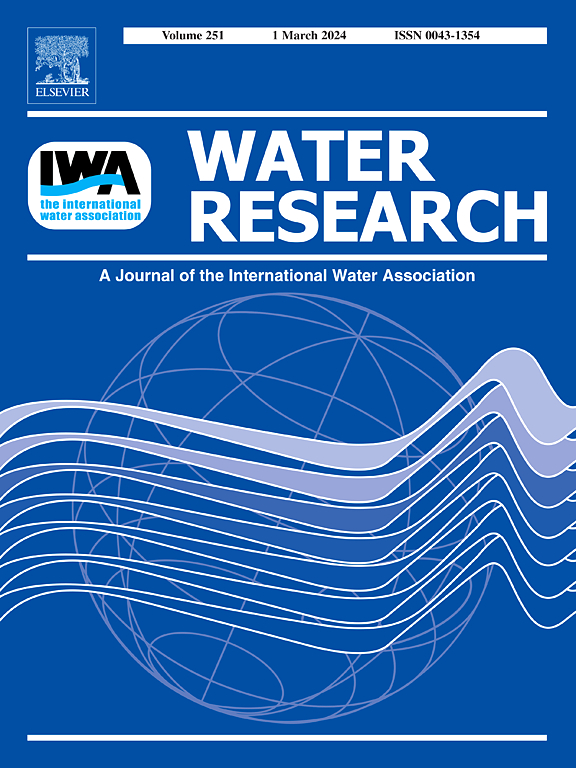Machine Learning-Driven Dynamic Prediction and Optimization for Ammonia Recovery in Membrane Distillation System
IF 12.4
1区 环境科学与生态学
Q1 ENGINEERING, ENVIRONMENTAL
引用次数: 0
Abstract
Ammonia recovery is crucial for environmental protection and resource sustainability, as it helps mitigate nitrogen pollution and enables recycling of valuable resources. Membrane distillation (MD) is a promising approach for high-purity ammonia recovery, but optimizing its performance relies on understanding dynamic ammonia transport under varying conditions. Conventional theoretical models often lack the flexibility to capture complex system dynamics, while empirical models fail to generalize beyond specific experimental scenarios. Here, we integrate machine learning (ML) with dynamic simulation techniques to model complex nonlinear interactions, embedding empirical inference into theoretical frameworks. Key input variables influencing the instantaneous rate of ammonia concentration change—such as temperature, pH, and ammonia partial pressure gradient—were identified through theoretical analysis. An artificial neural network (ANN) was developed to simulate the instantaneous rate of change of ammonia concentration on the feed side, achieving a high accuracy on the test set (R2 = 0.8537). The ANN was further combined with the fourth-order Runge-Kutta (RK4) algorithm to predict real-time ammonia concentrations and the cumulative ammonia recovery rate. To optimize the instantaneous MD performance for ammonia, a wide range of ML-based operational condition grid predictions was performed to identify optimal parameters. This study enhances the comprehension of ammonia transport mechanisms in MD systems while simultaneously advancing real-time process control and adaptive optimization, promoting both theoretical development and practical implementation.

膜蒸馏系统氨回收的机器学习驱动动态预测与优化
氨回收对环境保护和资源可持续性至关重要,因为它有助于减轻氮污染并实现宝贵资源的循环利用。膜蒸馏(MD)是一种很有前途的高纯度氨回收方法,但其性能的优化依赖于对不同条件下氨的动态传输的理解。传统的理论模型往往缺乏捕捉复杂系统动力学的灵活性,而经验模型则无法推广到特定的实验场景之外。在这里,我们将机器学习(ML)与动态仿真技术相结合,以模拟复杂的非线性相互作用,将经验推断嵌入到理论框架中。通过理论分析,确定了影响氨浓度瞬时变化率的关键输入变量,如温度、pH和氨分压梯度。利用人工神经网络(ANN)模拟了进料侧氨浓度的瞬时变化率,在测试集上获得了较高的准确性(R2 = 0.8537)。将人工神经网络与四阶龙格-库塔(RK4)算法结合,实时预测氨浓度和累积氨回收率。为了优化氨的瞬时MD性能,进行了广泛的基于ml的操作条件网格预测,以确定最佳参数。本研究增强了对MD系统中氨输运机制的理解,同时推进了实时过程控制和自适应优化,促进了理论发展和实际应用。
本文章由计算机程序翻译,如有差异,请以英文原文为准。
求助全文
约1分钟内获得全文
求助全文
来源期刊

Water Research
环境科学-工程:环境
CiteScore
20.80
自引率
9.40%
发文量
1307
审稿时长
38 days
期刊介绍:
Water Research, along with its open access companion journal Water Research X, serves as a platform for publishing original research papers covering various aspects of the science and technology related to the anthropogenic water cycle, water quality, and its management worldwide. The audience targeted by the journal comprises biologists, chemical engineers, chemists, civil engineers, environmental engineers, limnologists, and microbiologists. The scope of the journal include:
•Treatment processes for water and wastewaters (municipal, agricultural, industrial, and on-site treatment), including resource recovery and residuals management;
•Urban hydrology including sewer systems, stormwater management, and green infrastructure;
•Drinking water treatment and distribution;
•Potable and non-potable water reuse;
•Sanitation, public health, and risk assessment;
•Anaerobic digestion, solid and hazardous waste management, including source characterization and the effects and control of leachates and gaseous emissions;
•Contaminants (chemical, microbial, anthropogenic particles such as nanoparticles or microplastics) and related water quality sensing, monitoring, fate, and assessment;
•Anthropogenic impacts on inland, tidal, coastal and urban waters, focusing on surface and ground waters, and point and non-point sources of pollution;
•Environmental restoration, linked to surface water, groundwater and groundwater remediation;
•Analysis of the interfaces between sediments and water, and between water and atmosphere, focusing specifically on anthropogenic impacts;
•Mathematical modelling, systems analysis, machine learning, and beneficial use of big data related to the anthropogenic water cycle;
•Socio-economic, policy, and regulations studies.
 求助内容:
求助内容: 应助结果提醒方式:
应助结果提醒方式:


